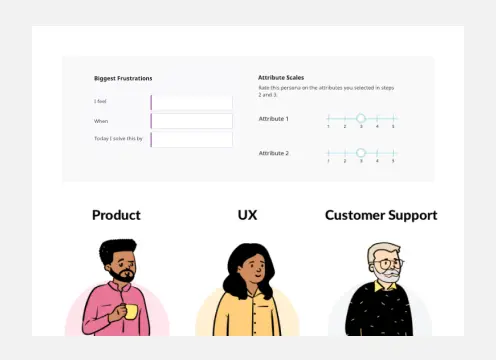The Lean Inception workshop template offers a comprehensive series of activities, typically scheduled over the course of a week that helps teams understand, align and plan the building of the MVP – Minimum Viable Product – and the product increments.
When to use The Lean Inception template?
As a product leader or facilitator, you want to align the different perspectives – business, User eXperience and technical – to achieve best product development possible right now.
The Lean Inception workshop is highly recommended in two main circumstances.
Large projects find a lean inception valuable to start quickly and be oriented to work in a lean style. Such a start builds early iterations designed to discover and test what features are truly valued by their users.
Smaller organizations (such as startups) use lean inceptions to take an idea that's been tested by some pre-software MVPs and evolve it into a software product.
This workshop is specifically about understanding an MVP, it doesn't substitute for ideation sessions, customer research, architectural review, or competitive analysis. It's one specific technique that's part of understanding what it takes to build a successful product.
How does The Lean Inception template work?
You’ll be guided through a 5-day workshop with a comprehensive step-by-step instruction and facilitation tips for each activity:
Day 1: Kick-off; Product Vision; Is- Is Not – Does – Does not do; Product Goals.
Day 2: Personas; User journeys.
Day 3: Features Brainstorming; Business, UX and Technical Review.
Day 4: Journeys and Feature; Sequencer
Day 5: MVP Canvas; Showcase.

Paulo Caroli
Expert Inception Facilitator
Paulo Caroli is the author of the best-selling book “Lean Inception: How to Align People and Build the Right Product” (the first on a series of books about Lean Strategy).
Categories
Similar templates
Parking Lot Matrix Template

Parking Lot Matrix Template
When the creative energy is flowing, a workshop or meeting will yield a lot of new ideas — but not all are on-topic or currently feasible. Roll them right onto a parking lot matrix, a simple, effective tool for separating the best ideas from those that are promising but could use more research or discussion. This template will let you easily make your own parking lot matrix, which will come in especially handy during long meetings (and when you have teammates who tend to go off-topic).
Personas Workshop
Breakout Group Template

Breakout Group Template
Breakout groups provide an excellent opportunity for teammates to have candid conversations and connect on a more intimate level than is possible during a broader meeting. When you’re in a large group setting, it can be difficult for people to feel safe or comfortable speaking up. In a smaller group, participants can feel safer sharing their ideas. Since the group is more intimate, teams are empowered to participate rather than observe.
Parking Lot Matrix Template

Parking Lot Matrix Template
When the creative energy is flowing, a workshop or meeting will yield a lot of new ideas — but not all are on-topic or currently feasible. Roll them right onto a parking lot matrix, a simple, effective tool for separating the best ideas from those that are promising but could use more research or discussion. This template will let you easily make your own parking lot matrix, which will come in especially handy during long meetings (and when you have teammates who tend to go off-topic).
Personas Workshop
Breakout Group Template

Breakout Group Template
Breakout groups provide an excellent opportunity for teammates to have candid conversations and connect on a more intimate level than is possible during a broader meeting. When you’re in a large group setting, it can be difficult for people to feel safe or comfortable speaking up. In a smaller group, participants can feel safer sharing their ideas. Since the group is more intimate, teams are empowered to participate rather than observe.
